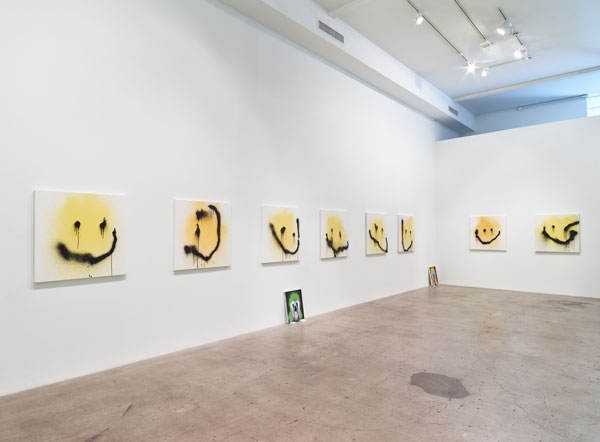Dynamics of style, technique, technology and authorship are at issue in an exhibition of new landscapes, portraits, still lifes, and abstractions by the painter KATSU. That’s not only due to the liberal citations of the Western art canon which feed his interpretations, but because of how he manifests them. He paints in a liminal space between the gestural hand of the artist and automated machinery, running a drone outfitted with spray enamel. Though normally thought of as an implement of war or surveillance, KATSU doesn’t use his drone as a weapon—unless you count taking on art history.
In some ways, the dynamic is a variation of the by-another-means playbook of rendering famous works in clay, or Lego bricks, or sandwich stuff (Eleanor Macnair, Andy Bauch, Blue Noses). But with a lot of those undertakings, the idea is to recreate well in unconventional materials. KATSU’s work is operating on another level, one in which the new technology and mediums are allowed to transform the original citation into a new vision, preserving the core of his inspirations, while also privileging his materials and the agency of the drone, which he calls a “semi-autonomous collaborator.” He’s not only reinterpreting art historical iconography for a modern zeitgeist, he’s doing it within a fresh combination of tech and street art. More than Postmodern, its upcycling of the old school is an embodiment of the present moment, and his medium is paramount in the power of his idea.
Of all the series, the smiley face emoji pictures are most Instagram-friendly, in a from-whence-it-came sort of way. With grabs at Pop art as well as smartphone cultural linguistics, the series eschews the pristine perfection of digital design and injects a wavering variability into the glowing mostly yellow central orbs, blotchy eyes and cryptic mouths. Out of context, those seasick lines would not read as wide eyes or crooked smiles; the premise requires the intentionality of the reference to make its point. “End of Life Face” for example, projects an opium dreamstate; “Inner Face” a slack stack of muddled features; and “Inner” a psychological surreal.
The Warholian Drone Flowers are suffused with vibrant and complex color stories. Somehow KATSU manages to achieve an almost impasto texture with spray paint. Warhol contemplated classics through contemporary means. KATSU does the same with Warhol. Similarly, KATSU’s Royalty portraits procure the requisite visual cues for facial structure; they are unmistakably portraiture, the titles reinforce the reference to historical court painting. Likeness is beyond the point. His large-scale Dot paintings, on the other hand, a merger of Hirst and Monet, create a sense of pictorial space through pure color alone, and of all the works most closely resemble their source imagery—which might say more about those sources than about KATSU’s subversions of them. In a side gallery, an untitled video shows the drone at work, composing a figurative line drawing. The effect is not unlike the films of Picasso and Pollock working performatively for the camera. If the demo was meant to clarify the distinctions between human and robot artistry, instead it only deepens the paradox.



